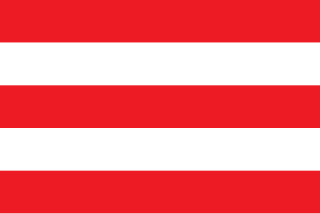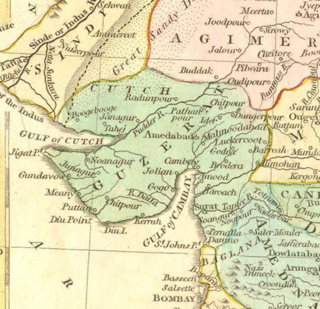
Kathiawar is a peninsula, near the far north of India's west coast, of about 61,000 km2 (23,500 sq mi) bordering the Arabian Sea. It is bounded by the Gulf of Kutch in the northwest and by the Gulf of Khambhat in the east. In the northeast, it is connected to the rest of Gujarat and borders on the low, fertile hinterland of Ahmedabad. It is crossed by two belts of hill country and is drained radially by nine rivers which have little natural flow aside from in monsoon months, thus dams have been built on some of these. Kathiawar ports have been flourishing centres of trade and commerce since at least the 16th century.

Jamnagar is a city and the headquarters of Jamnagar district in the Indian state of Gujarat. The city lies just to the south of the Gulf of Kutch, some 337 kilometres (209 mi) west of the state capital, Gandhinagar.

Nawanagar was an Indian princely state in the historical Halar region, located on the southern shores of the Gulf of Kutch. It was ruled by the Jadeja Rajput dynasty and became a part of newly formed India. Its capital city was Nawanagar city, now known as Jamnagar. It had an area of 3,791 square miles (9,820 km2) and a population estimated at 336,779 in 1901. Its rulers, who use the title of "Jam Saheb" are of the same clan as the Rao of Kutch. They were entitled to a 13-gun salute. The state flag was a rectangular red flag with a white elephant, near and facing the hoist. During the British, the state was part of the Kathiawar Agency, within the Gujarat Division of Bombay Presidency.

Jamnagar District is a district of Gujarat in Western India. Its headquarters are located in the eponymous city of Jamnagar. It hosts the production facilities of large Indian companies such as Reliance. Among its attractions are several palaces, a Marine National Park and a Bird Sanctuary, known as Khijadiya Bird Sanctuary. In 2013, Devbhoomi Dwarka district was carved out of the western part of the district.

Halar (Haalaar) is a historical region of western India, located by the Gulf of Kutch coast on the northwestern area of Nawanagar, now Jamnagar, in Gujarat State, on Saurashtra peninsula, roughly corresponding to the present Jamnagar District, Devbhumi Dwarka district, Morbi District and Rajkot District.

Dhrol is a city and a municipality in Jamnagar district in the state of Gujarat, India.

Saurashtra State, formally known as United State of Kathiawar and later United State of Saurashtra, was a State of India that existed between 1948 and 1956, on Saurashtra alias Kathiawar peninsula, with Rajkot as its capital,

The Paliya or Khambhi is a type of a memorial found in the western regions of the India subcontinent, especially Saurashtra and Kutch regions of Gujarat and also in Sindh region of Pakistan. They mostly commemorate the death of a person. These stone monuments have symbols and inscriptions. There are several types of memorials including dedicated to warriors, sailors, sati, animals and figures associated with folklore. They are important in ethnography and epigraphy.

Jam Rawal Lakh (1480–1562), was a Jadeja Rajput ruler, who ruled Kutch State from 1524 to 1548 and later was founder-ruler of Nawanagar State from 1540 to 1562.

Makaji Meghpar is a village and former chiefdom of Hardhrol Jadeja chieftains in the Jamnagar district of Gujarat, India. It was founded in 1754 by Makanji Jadeja of Dhrol State. Gujarati writer Harilal Upadhyay was from the village. The people are mainly Jadeja Rajputs with some Brahmins, Patels and Dalits.

The Battle of Bhuchar Mori, also known as Battle of Dhrol, was fought between the army of Kathiawar led by Nawanagar State and the Mughal army at Bhuchar Mori plateau near Dhrol, Saurashtra. It was meant to protect Muzaffar Shah III, the last Sultan of Gujarat Sultanate who had taken asylum under Jam Sataji of Nawanagar after his escape from the Mughal emperor Akbar. It was fought in July 1591. The Kathiawar army included the armies of Junagadh who betrayed Nawanagar and joined the Mughal army at last. The battle led to a large number of casualties on both sides. The battle resulted in the victory of the Mughal army.

Milind Gadhavi is a Gujarati language poet and lyricist from Gujarat, India. He has penned songs for several Gujarati movies. He is a recipient of the 15th Transmedia award for best lyrics for Gujarati film, Premji: Rise of a Warrior.
Bagasara-Ghed, also known as Bagasara (Sil), is a village in Mangarol Taluka of Junagadh district, Gujarat, India. Bagasra-Ghed lies thirty-four miles to the south-west of Junagadh.
Balachadi is a village in Jodiya Taluka of Jamnagar district, Gujarat, India. It is 25 kilometres east of Jamnagar, near the Gulf of Kutch.
Shams-ud-Din Muzaffar Shah III was the last sultan of the Muzaffarid dynasty who nominally reigned over the Gujarat Sultanate, a late medieval kingdom in India from 1561 to 1573 though true powers were exerted by his nobles. Mughal Emperor Akbar annexed Gujarat into his empire in 1573. Muzaffar Shah III was taken prisoner to Agra. In 1583, he escaped from the prison and with the help of the nobles succeeded to regain the throne for a short period before being defeated by Akbar's general Abdul Rahim Khan-I-Khana in January 1584. He fled and finally took asylum under Jam Sataji of Nawanagar State. The Battle of Bhuchar Mori was fought between the Mughal forces led by Mirza Aziz Koka and the combined Kathiawar forces in 1591 to protect him. He finally committed suicide in 1592 when he was surrendered to the Mughal by the ruler of Cutch State.
In 1573, Mughal Emperor Akbar conquered Gujarat Sultanate taking advantage of young Gujarat Sultan Muzaffar Shah III and his quarrelling nobles. Muzaffar was held captive at Agra. He appointed his foster brother Mírza Âzíz Kokaltásh as the first viceroy who faced an insurrection by the rebel nobles of the former Sultanate. Akbar quickly came to aid and ended the insurrection. He soon appointed Mírza Khán who managed to set revenue system and quelled attack by the Mirzas with help of Mughal minister Todar Mal. The next viceroy Shaháb-ud-dín strengthened the military. Soon Sultan Muzaffar escaped, returned to Gujarat and led an attack on Ahmedabad and recaptured it before his former noble and now viceroy Itimad Khan reach the city. Soon Mirza Khan was reappointed as the viceroy who defeated Muzaffar in the battle of Fatehwadi in 1584. Soon Kokaltásh returned as the viceroy and defeated Muzaffar and combined Kathiawad forces in battle of Bhuchar Mori. Later Muzaffar was captured but he committed suicide, putting an end to the Gujarat Sultanate. As Kokaltásh went to the Mecca on pilgrimage, Sultan Murad Bakhsh was appointed as the viceroy on whose death, Kokaltásh returned third time as the viceroy. Akbar was succeeded by Jehangir.

The last two Gujarat Sultans, Ahmad Shah III and Mahmud Shah III, were raised to throne when they were young so the nobles were ruling the Sultanate. The nobles divided territories between themselves but soon started fighting between themselves for supremacy. One noble invited the Mughal emperor Akbar to intervene in 1572 which resulted in the conquest of Gujarat by 1573 and Gujarat becoming the province of the Mughal Empire.

The Gujarat Subah was a province (subah) of the Mughal Empire, encompassing the Gujarat region. The region first fell under Mughal control in 1573, when the Mughal emperor Akbar defeated the Gujarat Sultanate under Muzaffar Shah III.
Ra Meliga, also known as Melaga or Maleka, was a Chudasama king of Saurashtra region of western India who reigned from 1400 CE to 1416 CE. He remove his capital from Vanthali back to Junagadh, from which place he expelled the thanadar appointed by Gujarat Sultan. Thus Gujarat Sultan Ahmad Shah I sent an army against Junagadh. He captured Vanthali and later Junagadh was besieged. Meliga left to a fort on Girnar hill which was inaccessible to the forces. So the forces left and placed two officers in Junagadh to collect tribute. Meliga died and was succeeded by his son Jayasimha II in 1416 CE.
Ranakadevi was a legendary 12th century queen of Khengara, the Chudasama ruler of Saurashtra region of western India. She is mentioned in the bardic tragic romance representing the battle between Chudasama king Khengara and Chaulukya king Jayasimha Siddharaja. However, this legend is not credible.






















